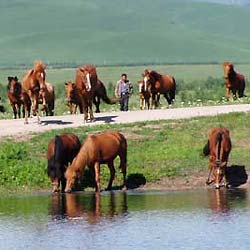
The Sanhanba National Forest Park in Bashang, Hebei Province is the largest forested park in China, with scenic forests, dots of larches and white birches, and grassland.
Lakes, brooks and ponds saturate the prairies and the woods, which have become home to a very rich biodiversity.
The 94,000-hectare park used to be a part of the off-limits hunting grounds of Qing Dynasty (1644-1911) emperors. Afterwards, it was reduced to a barren land. Luckily the dogged reforestation effort since 1962 led by local people and college students who volunteered to settle there changed the area for the better and restored its former glamour.
Located 420 kilometers north of Beijing, the park has become one of China's top tourist locations and a major photographic destination for Chinese and international landscape photographers alike.
After six hours of driving from downtown Beijing, tourists will instantly leap with joy when they hear birds chirping and seeing multiple flowers blooming.
Purple, crimson, yellow, white, deep or light blue flowers in different sizes and shapes all stand proudly in the pure sunlight.
Even on meadows where few flowers grow, the grass has a fragrance that no perfume can rival.
Seeing the whole forest park make one feel like a long-lost child finally coming home, savoring the joy of being in Mother's arms again.
In addition to the clear sky, white clouds, refreshing breeze, streams, lakes, hills and flowers, Sanhanba also offers dense woods.
Driving up the mountainside, tourists might marvel at trees that have won the struggle for survival against soil erosion over the last few decades.
This is a world so untouched by urbanization that you might find it an eyesore to spot a city right in the centre of the park. The sight of cement roads and concrete buildings with glass walls instead of natural wooden huts may make your heart sink.
Yet the upside of this ugly urbanization is that you can find comfortable lodging in the middle of the forests, enabling you to enjoy a starry night with a bonfire party featuring roasted lamb and folk dancing. Moreover, local people explain that wooden huts are not feasible because of the humid weather. Such huts would become breeding grounds for parasites and would be detrimental to the surrounding forest.
If you get up earlier to enjoy the sunrise, you could even spot wild animals drinking at nearby brooks covered by morning mist.
Horse riding is another treat the park offers. However, if you want to ride a horse without the herdsman leading the animal, you have to sign a waiver.
If horse riding isn't your thing, consider lying in a raft and drifting along a limpid brook covered by a canopy of trees.
In a forest park so large that it takes more than two hours to cross by car, it could take a full month to explore every corner. But if you are here for a weekend, Seven-Star Lake (a lake consisting of seven ponds) and the Taifeng Lake are not to be missed.
Take a bird's-eye view from the seven-storey Sanha Tower, which stands at the highest point of the park. Telescopes are provided, since forest managers use them to monitor the forest in case of fire.
Tour guides may tell you the best season to visit is autumn, when professional photographers and filmmakers would make their way back to the area like they used to, because "the charm of the valley has been proven irresistible."
How to get there
-- By bus: Go to Xizhimen Bus Station (2 Beixiaguan, Xizhimen, Haidian District, 6217-3556) and take one heading for the County Seat of Weichang County. Buses for Weichang leave in the morning and depending on road conditions. It takes between six and eight hours to get there.
-- By train: Take Train 2189 from Beijing Train Station and take off at Siheyong, about a seven-hour ride; hard-sleeper ticket: about 70 yuan (US$8.80.) From Siheyong you need to take a bus to Weichang (about a 20-minute drive).
Once in Weichang, you will need to take either a public bus or a taxi to Sanhanba National Forest Park, which is roughly a one-hour drive.
Take notes
Saihanba National Forest Park, on the average, is 1,500 meters above sea level. Make sure you bring sunblock, even in autumn!
Daily temperature variations can be quite drastic; make sure to bring enough warm clothing.
For those who go to the park by train and bus, it is better to hire a jeep in Weichang County to travel to forested zones. For those driving to the park for first time, it is better to hire a guide to avoid taking a roundabout way.
For lodging, visiting the park on weekdays would be best.
There will be sudden rainstorms sometimes in the summer.
Ticket: 70 yuan (US$8.78) per person.
Lodging: There are inns and hotels that charge 100 yuan (US$12.54) or more per night for a bed. There are also family inns where visitors can experience the warmth and hospitality of the people on the grasslands.
Tel: 0314-780-2673.
(China Daily August 4, 2006)
|

